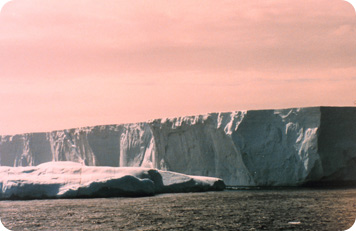Anyone who’s heard the tale of the Titanic knows that icebergs hold the power of life and death. They can mean sudden death for any ship that doesn’t give them the proper respect. And their own births can destroy ocean life, while their deaths can sow the seeds of new life.
 A large tabular iceberg off the Antarctic Peninsula. Credit: National Oceanic & Atmospheric Administration
A large tabular iceberg off the Antarctic Peninsula. Credit: National Oceanic & Atmospheric AdministrationAn iceberg is born when it breaks off the edge of a glacier. Before it breaks free, though, it can scour the ocean floor, grinding up the organisms that live on the bottom. And when too many icebergs jam up the seas, they can crowd out plankton -- the tiny organisms that form the first link of the marine food chain.
Yet an iceberg can also serve as a giant fertilizer spreader, supplying the nutrients for plankton and creating an explosion of life.
Scientists from California recently studied a couple of giant icebergs in the Weddell Sea, off the coast of Antarctica. They found that as the bergs melt, they release dust that fell out of the atmosphere and was frozen into the glaciers. The dust contains iron and other nutrients. The release of a lot of these nutrients can spawn a big bloom of plankton.
And where you have plankton, other organisms follow. Little shrimp-like creatures called krill eat the plankton. Fish, jellyfish, and whales eat the krill. Birds stock up on krill, too, using the melting icebergs as bases of operation. Bigger fish come to eat the little fish, and so do seals and penguins.
This process creates floating islands of life -- islands that can support a thriving ecosystem for miles around.

